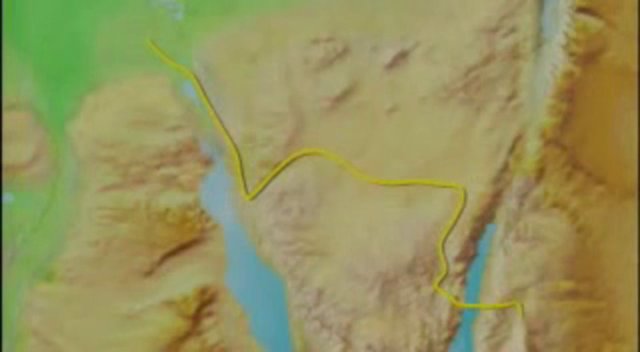
By Rabbi Ari Enkin, rabbinic director, United with Israel
Upon leaving Egypt, the Jews crossed the Yam Suf, which is commonly translated as the Red Sea. The question is: What and where is the Yam Suf of the Bible?
The name Yam Suf appears throughout Scripture 23 times. Many sources that translate Yam Suf as Red Sea indicate that literally, it means Sea of Reeds or Rushes. In Exodus 13:18, describing the Jews fleeing Egypt, the Torah states: “God took the people in a roundabout path . . . to Yam Suf.” Publisher ArtScroll’s Stone Edition bible translates Yam Suf as Sea of Reeds, noting that what is today known as the Red Sea is situated too far south for the Jews to have crossed it upon fleeing Egypt. The JPS bible simply calls it the “Sea of Reeds,” and the Koren bible calls it the Sea of Suf, with no attempt at translation or identification.
In order to determine which body of water is the Yam Suf, it is important to look for parallels in Tanach (Scripture). According to famous Biblical commentator Rashi, the word “suf” is similar to the Hebrew word agam, which means a pond that has reeds (kanim) growing in it. This means that Yam Suf was a sea full of reeds. Problem: Reeds are not found at the edge of a salty body of water such as the Red Sea.
In I Kings (9:26) it states that King Solomon based his navy at Yam Suf near Eilat. This Yam Suf was probably not the one crossed by the Israelites and may have been termed “red” due to the inhabitants of the surrounding mountains, the people of Edom (see Genesis 25:30), which means red. Alternatively, it may have been named for the reddish coral in the vicinity. (This is also probably how the country Eritrea got its name. Eritrea, whose name is a rendition of the ancient Greek name Erythraía, or the “Red Land,” is located on the southwestern shore of the Red Sea.) It is also suggested that the Gulf of Aqaba, which flows past ancient Edom and into Eilat, was once known as Yam Edom, which can mean the Sea of Edom or the Red Sea. So Rashi suggests that this name was eventually transferred, erroneously, to the other side of the Sinai (the Gulf of Suez), where it stuck.
This discussion is obviously relevant in trying to discover the route of the Exodus.
If Yam Suf is a sea with reeds, it rules out identifying it as either the Red Sea or the Mediterranean. The Red Sea is a long saltwater inlet separating the Arabian Peninsula from the east coast of Egypt. As mentioned, any sea with reeds would have to be freshwater, or at least brackish, in order for reeds to flourish at its shore. This lends credence to the theory that Yam Suf was one of the shallow, marshy, bitter lakes east of the Nile Delta, such as a shallow spot connecting the Great and Little Bitter Lakes.
Three Scholarly Opinions
There are three primary Exodus-route theories among scholars that are accepted today.
Some propose a northern route, whereby the Israelites went north to the coast and then eastward, and the “sea” that they crossed was part of Lake Sirbonis, an arm or bay of the Mediterranean, before turning southward into the Sinai Peninsula. Others, suggesting a central route, claim that the body of water crossed was a shallow lake north of the Red Sea called the Reed Sea. Indeed some of the lakes north of the Red Sea are abundant with reed-like plants. Finally, there are those who suggest a southern route, which is the route traditionally assumed to be correct.
More than One Red Sea?
In I Kings 9:26 it states: “King Solomon also built a fleet of ships at Etzion Geber, which is near Eilat on the shore of the Red Sea [Yam Suf ], in the land of Edom.” If Yam Suf were a marshy lake close to Egypt, this would certainly be a strange place for King Solomon to build his great fleet! This event probably took place at the northernmost end of the Gulf of Aqaba, the same location of modern-day Eilat! Another reference indicating that Yam Suf is the modern Red Sea is the list of encampments of the Jewish people in the desert, as found in Numbers 33: 8-10. The Torah states that after the Israelites crossed “the Yam,” they camped first in Marah and then Elim until finally “they camped by the Yam Suf.” How could they have crossed the Sea of Reeds and, after many days of travel, still camped by that same Sea of Reeds? No body of water in the region except the Red Sea is large enough for them to have traveled for so long and still be close to its coast. Other references that support the identification of “Yam Suf” with “Red Sea” are Numbers 21:4, Deuteronomy 1:40, 2:1 and Jeremiah 49:21.
What’s going on here?
It is likely that the name Yam Suf and/or Red Sea was applied in the ancient world to more than one location.
Bottom line, dear readers: Nobody knows exactly where the Jewish people crossed the Yam Suf!
This article is based on the works of Rabbi Dr. Ari Zivotofsky. For more of his fascinating insights, visit halachicadventures.com.
